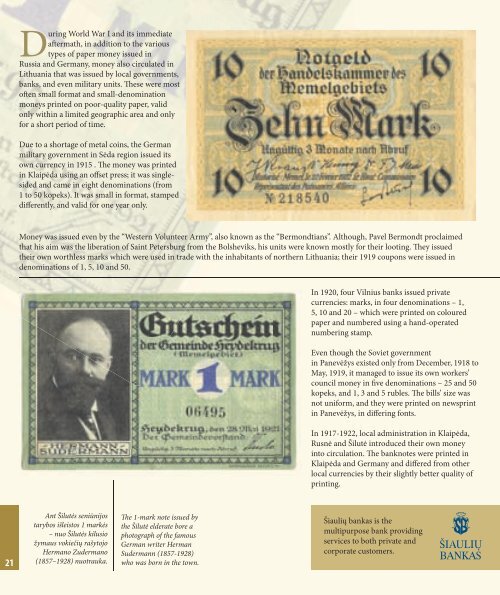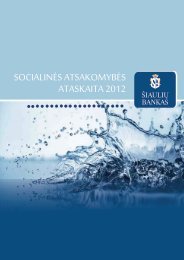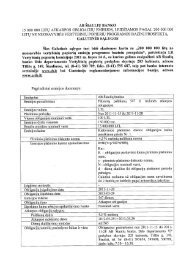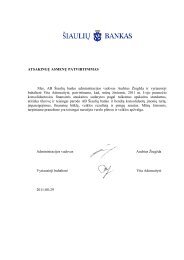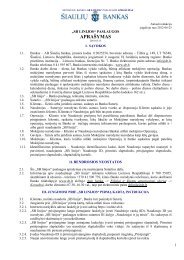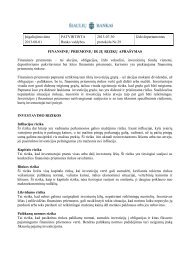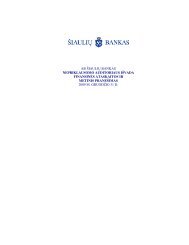Po 1871 m., kai susikūrė Vokietijos imperija, markė ... - Šiaulių bankas
Po 1871 m., kai susikūrė Vokietijos imperija, markė ... - Šiaulių bankas
Po 1871 m., kai susikūrė Vokietijos imperija, markė ... - Šiaulių bankas
You also want an ePaper? Increase the reach of your titles
YUMPU automatically turns print PDFs into web optimized ePapers that Google loves.
21<br />
During World War I and its immediate<br />
a� ermath, in addition to the various<br />
types of paper money issued in<br />
Russia and Germany, money also circulated in<br />
Lithuania that was issued by local governments,<br />
banks, and even military units. � ese were most<br />
o� en small format and small-denomination<br />
moneys printed on poor-quality paper, valid<br />
only within a limited geographic area and only<br />
for a short period of time.<br />
Due to a shortage of metal coins, the German<br />
military government in Sėda region issued its<br />
own currency in 1915 . � e money was printed<br />
in Klaipėda using an o� set press; it was singlesided<br />
and came in eight denominations (from<br />
1 to 50 kopeks). It was small in format, stamped<br />
di� erently, and valid for one year only.<br />
Money was issued even by the “Western Volunteer Army”, also known as the “Bermondtians”. Although, Pavel Bermondt proclaimed<br />
that his aim was the liberation of Saint Petersburg from the Bolsheviks, his units were known mostly for their looting. � ey issued<br />
their own worthless marks which were used in trade with the inhabitants of northern Lithuania; their 1919 coupons were issued in<br />
denominations of 1, 5, 10 and 50.<br />
Ant Šilutės seniūnijos<br />
tarybos išleistos 1 <strong>markė</strong>s<br />
– nuo Šilutės kilusio<br />
žymaus vokiečių rašytojo<br />
Hermano Zudermano<br />
(1857–1928) nuotrauka.<br />
� e 1-mark note issued by<br />
the Šilutė elderate bore a<br />
photograph of the famous<br />
German writer Herman<br />
Sudermann (1857-1928)<br />
who was born in the town.<br />
In 1920, four Vilnius banks issued private<br />
currencies: marks, in four denominations – 1,<br />
5, 10 and 20 – which were printed on coloured<br />
paper and numbered using a hand-operated<br />
numbering stamp.<br />
Even though the Soviet government<br />
in Panevėžys existed only from December, 1918 to<br />
May, 1919, it managed to issue its own workers’<br />
council money in � ve denominations – 25 and 50<br />
kopeks, and 1, 3 and 5 rubles. � e bills’ size was<br />
not uniform, and they were printed on newsprint<br />
in Panevėžys, in di� ering fonts.<br />
In 1917-1922, local administration in Klaipėda,<br />
Rusnė and Šilutė introduced their own money<br />
into circulation. � e banknotes were printed in<br />
Klaipėda and Germany and di� ered from other<br />
local currencies by their slightly better quality of<br />
printing.<br />
<strong>Šiaulių</strong> <strong>bankas</strong> is the<br />
multipurpose bank providing<br />
services to both private and<br />
corporate customers.


